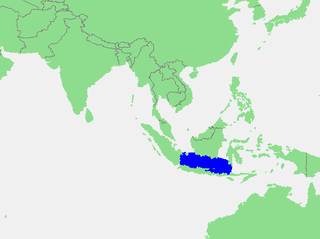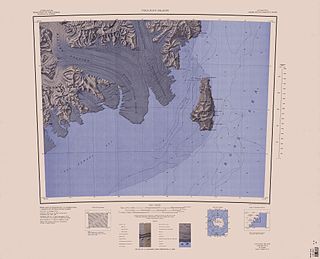
The geography of France consists of a terrain that is mostly flat plains or gently rolling hills in the north and west and mountainous in the south and the east.

The Java Sea is an extensive shallow sea on the Sunda Shelf. It lies between the Indonesian islands of Borneo to the north, Java to the south, Sumatra to the west, and Sulawesi to the east. Karimata Strait to its northwest links it to the South China Sea.

Borchgrevink Glacier is a large glacier in the Victory Mountains, Victoria Land, draining south between Malta Plateau and Daniell Peninsula, and thence projecting into Glacier Strait, Ross Sea, as a floating glacier tongue, the Borchgrevink Glacier Tongue, just south of Cape Jones. It was named by the New Zealand Geological Survey Antarctic Expedition, 1957–58, for Carsten Borchgrevink, leader of the British Antarctic Expedition, 1898–1900. Borchgrevink visited the area in February 1900 and first observed the seaward portion of the glacier.

Frost Glacier is a channel glacier flowing to the head of Porpoise Bay, Antarctica. It was delineated from air photos taken by U.S. Navy Operation Highjump (1946–47), and named by the Advisory Committee on Antarctic Names for John Frost, boatswain on the brig Porpoise of the United States Exploring Expedition (1838–42) under Charles Wilkes.

Totten Glacier is a large glacier draining a major portion of the East Antarctic Ice Sheet, through the Budd Coast of Wilkes Land in the Australian Antarctic Territory. The catchment drained by the glacier is estimated at 538,000 km2 (208,000 sq mi), extending approximately 1,100 km (680 mi) into the interior and holds the potential to raise sea level by at least 3.5 m (11 ft). Totten drains northeastward from the continental ice but turns northwestward at the coast where it terminates in a prominent tongue close east of Cape Waldron. It was first delineated from aerial photographs taken by USN Operation Highjump (1946–47), and named by Advisory Committee on Antarctic Names (US-ACAN) for George M. Totten, midshipman on USS Vincennes of the United States Exploring Expedition (1838–42), who assisted Lieutenant Charles Wilkes with correction of the survey data obtained by the expedition.

Hall Island is an island in Franz Josef Land, Arkhangelsk Oblast, Russia.

Shearer Stack is a rock stack lying 1.5 miles (2.4 km) southwest of False Round Point, off the north coast of King George Island in the South Shetland Islands. Named by the United Kingdom Antarctic Place-Names Committee (UK-APC) in 1960 for the American sealing vessel Charles Shearer from Nantucket, which visited the South Shetland Islands in 1874-75. In 1877 the ship again sailed for the islands and disappeared without a trace.
Jacobsen Glacier is a glacier flowing east-northeast from Mount Reid, in the Holland Range, Antarctica, into the Ross Ice Shelf. It was mapped by the United States Geological Survey from Tellurometer surveys (1961–62) and Navy air photos (1960), and was named by the Advisory Committee on Antarctic Names for H. Jacobsen, Master of the USNS Chattahoochee during U.S. Navy Operation Deep Freeze 1964 and 1965.
Sohrab Goth is a suburb of Gadap Town in Karachi, Sindh, Pakistan. It acts as an entry point to Karachi from the rest of Pakistan. There is a bridge over the Lyari River connecting other areas of Karachi to Sohrab Goth. Bridge building started in 2000 and completed in 2006.
The Los Angeles Avenues refer to a series of 50 numbered streets in Los Angeles, California in the Northeast and Eastside regions. They are all designated with the word "Avenue" followed by a number such as "Avenue 64." The Avenues are located in the Los Angeles neighborhoods of Lincoln Heights, Cypress Park, Montecito Heights, Glassell Park, Highland Park,Mt. Washington and Eagle Rock. They are not related to 2nd through 13th Avenues west of Arlington Street in Jefferson Park.
SM U-99 was one of the 329 submarines serving in the Imperial German Navy in World War I.

The Alley Glacier is a glacier in Antarctica that drains the north slopes of Britannia Range in the vicinity of Ward Tower and flows north to Darwin Glacier. It is separated from Gaussiran Glacier by a series of large rock buttresses, including Robertson Buttress.

The borders of the oceans are the limits of the Earth's oceanic waters. The definition and number of oceans can vary depending on the adopted criteria.

Bills Gulch is a glacier on the southeast side of Hemimont Plateau, the northern of two glaciers flowing east from the plateau upland into the head of Trail Inlet, on the east coast of Graham Land. This glacier was used by the sledge party under Paul H. Knowles which traversed the Antarctic Peninsula from the East Base of the United States Antarctic Service (USAS) on its way to Hilton Inlet in 1940. It was named by USAS for a lead dog that died at this point. The unlikely name has been approved because of its wide use on maps and in reports.
Mount McLennan is a mountain 4 nautical miles (7 km) south of the Howard Hills in the northeast part of the Scott Mountains, Enderby Land, Antarctica. It was plotted from air photos taken from Australian National Antarctic Research Expeditions aircraft in 1956 and was named by the Antarctic Names Committee of Australia for K. McLennan, a member of the crew of the Discovery during the British Australian New Zealand Antarctic Research Expedition of 1929–31.
Hess Glacier is a glacier 5 nautical miles long, flowing east-northeast between steep rock walls to its terminus 10 nautical miles southwest of Monnier Point, on the east coast of Graham Land, Antarctica. It was charted in 1947 by the Falkland Islands Dependencies Survey, who named it for Hans Hess, a German glaciologist.
Law Glacier is a glacier about 10 nautical miles (20 km) wide between the south end of the Queen Elizabeth Range and the MacAlpine Hills, gradually descending east-northeast from the Antarctic polar plateau to Bowden Névé. It was named by the New Zealand party of the Commonwealth Trans-Antarctic Expedition (1956–58) for B.R. Law, Deputy-Chairman of the Ross Sea Committee.


![]()









